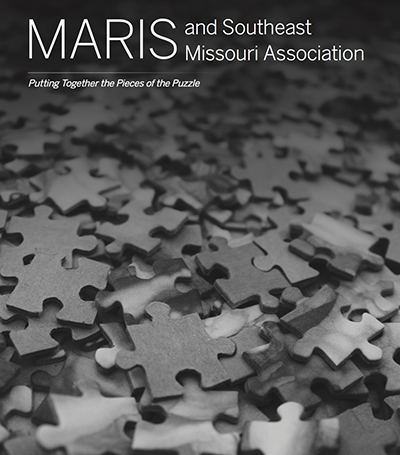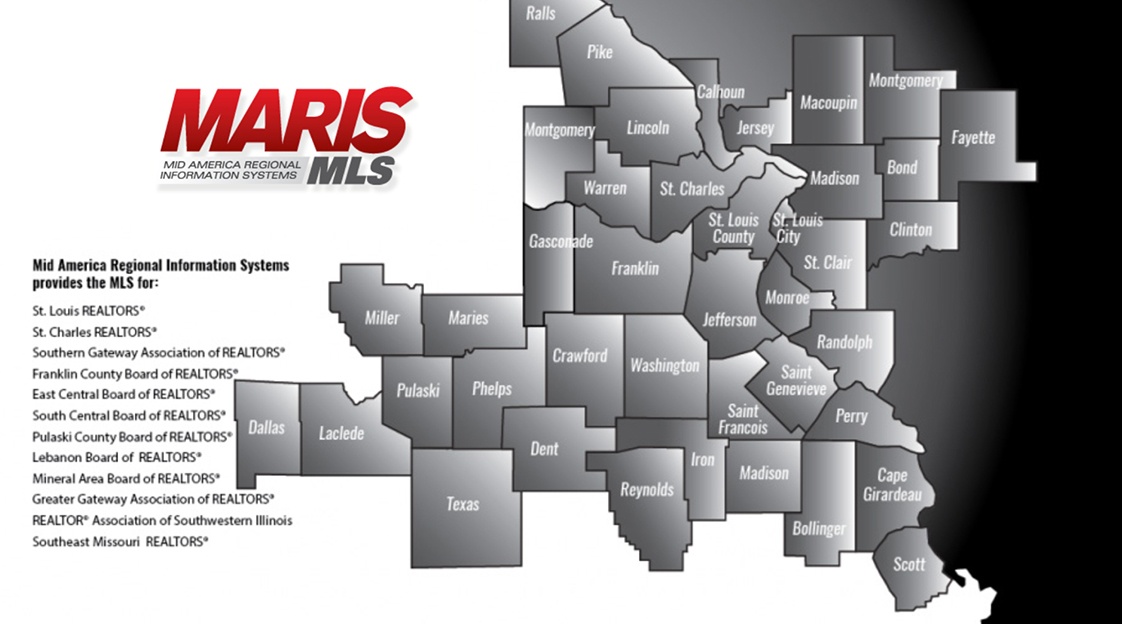More Consolidation Case Studies
Download this report (PDF: 307 KB)
Introduction

Back in the 1980s, four shareholder REALTOR® associations formed the Mid America Regional Information Systems (MARIS) as an independent, “association-owned and broker-driven” MLS. MARIS was structured to operate as a business rather than using the customary association model. At first, the associations’ resisted, largely for financial reasons, but the brokers instructed the associations to figure out a solution or they would do it on their own.
Like the pieces of a puzzle, these four unique associations found a way to come together with each one bringing its own value into the organization. By working together, they provided a more complete picture just like putting puzzle pieces together, we need to rotate them and change our perspective until we see how they will fit with the other pieces.
With a jigsaw puzzle, we understand what the finished product will look like from the picture on the box lid. With regional MLSs, there’s also a vision of what the big picture will look like. As MARIS has expanded over the years, each additional association that has joined has been like adding another puzzle piece to the whole. But as each association is unique, it takes patience, flexibility, and the ability to see how one fits into the organization along with the others.
Eight associations have since joined MARIS over the past eight years, which now serves as the regional MLS provider for approximately 12,000 REALTOR® members from associations in Missouri and Illinois including: St. Louis REALTORS®, St. Charles REALTORS®, Jefferson County, Franklin County, East Central, South Central, Pulaski County, Lebanon, and Mineral Area Boards of REALTORS®, and Southeast Missouri REALTORS®; and two associations from Illinois: REALTOR® Association of Southern Illinois, and Greater Gateway Association of REALTORS®. All of the associations’ markets are contiguous, covering 60 counties including approximately one-third of the state of Missouri.

Leadership
The founding “broker-driven” philosophy remains a part of the MARIS culture today. The brokers could see the big picture and they knew what they wanted and needed. But it has taken patient, flexible leadership to orchestrate putting the pieces together to achieve the brokers’ vision to date.
The leadership of Southeast Missouri Association of REALTORS®, one of the newer shareholders of MARIS, was faced with some challenges with their prior MLS system. Their software and database required a lot of work to fix what was broken. In addition, the expenses related to maintaining the RESO compliance standards and associated membership costs were issues the leadership had to deal with at the time.
Southeast Missouri created three specific committees to address the issues, including the MLS Committee, the System Specialist Committee, and the Syndication Committee. The committee chairs worked together to arrive at the consensus that it would be best to consider other options including the possibility of working with MARIS as their MLS provider.
The association’s leadership wisely involved their broker participants. In fact, they reached out to each one of them to communicate the options they were considering and held four to five meetings to inform them and get their support before proceeding. The options were to fix what was broken within their current system, hire a new MLS vendor, or work with MARIS as the provider of MLS to their 300 members.
Success Factors
Relationships and trust are key elements in every successful consolidation effort and MARIS works with others until the partnership produces a win-win outcome that is acceptable to both sides:
- Consolidation is the phrase for what MARIS has achieved by focusing on the partnership aspects of the process when talking with potential shareholders.
- A key to success is being aware of potential differences in selling customs in each market, being able to accommodate those differences, and making sure that every shareholder knows that they have a voice in the decision-making process.
- It’s important to be flexible while working within an existing proven framework. Each association has its own culture and their markets are unique in various ways and as a result don’t want a cookie-cutter solution. Therefore, it is important to understand their wants and needs in order to design a win-win consolidation solution.
- For Southeast Missouri, the members received more and better services from MARIS. The financial impact to the association was net positive and they are now able to be single focused on making the association better, rather than being spread-thin between running both the association and the MLS. The cost to the members remained unchanged and they receive Realist (public records) and a much better MLS software.
- The vote for the association was 80 percent in favor of working with MARIS for MLS services.
Main Drivers
In the beginning, economic and financial needs drove MARIS to think about ways to expand its membership. They served their original four shareholders until 2007–2008, but with the market downturn their membership declined and to restore their revenue stream MARIS chose to become a “reseller” to smaller associations. The objective has always been to provide better services to more REALTORS® at a lower cost.
- Cross-over and overlap are not big factors in this market so the focus is really product-driven and keeping the costs down.
- There are a significant number of opportunities for growth in both Illinois and Missouri, based on continuous and non-contiguous markets.
- For Southeast Missouri, the primary drivers for consolidation were the state of their MLS software and the costs and resources needed to be RESO compliant. They were also understanding the MLS so it wasn’t getting the dedicated attention it had enjoyed in the past.
Intended Benefits
- Better products delivered to members at a lower cost.
- It is easier for them to conduct business and make a living by having one MLS that covers the natural market area on both sides of the state line.
- The focus is primarily product-driven and therefore cross-over and overlap are not big factors with MARIS.
How the Issues Were Resolved
The smaller associations were resistant to change, and in some cases it took years to cultivate the relationships and trust before they were comfortable to move forward. The time frame varied as one of the partnerships took six years and another was completed in 90 days due to an accident that took the life of an AE.
TECHNOLOGY (MLS vendor platforms, auxiliary services, contractual obligations, hardware and software systems, lockboxes).
- Provided tax records where most neighboring MLS operations did not.
- Became the service provider for associations’ MLS operations.
- Better integrated services for a lower fee.
- MARIS provides a license for association management from Rapattoni, a light membership system used to receive electronic data feed for member information.
FINANCES (MLS operations, distribution to consolidating partners, funding association operations, reserves, real and personal property ownership, taxation etc.).
- Structured model where revenue flows back to the association in the form of a management fee (member/month).
- Payment is not guaranteed, not structured as a dividend, and may be adjusted as needed.
- Associations sign up members and transmit information to MARIS.
- When an association wants to become a shareholder there is a formula that analyzes the terms of the deal including: how long will it take MARIS to recoup payments to the association, increase in revenue to MARIS, and the cost of transition and conversion.
- New shareholders receive a one-time payment, based on the number of members. This is the “purchase fee” for MARIS and the transition fee for the association. This is a negotiable amount and may be paid in one lump sum, or spread out over several years to help associations adjust to a change in revenue stream.
- MARIS has a substantial budget for contributions to associations to help with event sponsorships, grants, special projects, and emergencies.
- For Southeast Missouri, the financials worked out just fine. The members pay the same amount as before MARIS for a much better system. The association is financially sound and focused on growing its non-dues revenue in areas including Professional Development.
GOVERNANCE (allocation of representation, election/appointment of representatives, reporting requirements, mix of brokers v. agents, transition from former models, etc.)
- The MARIS Board of Directors (BOD) consists of one director from each shareholder association. The three largest member brokers have appointments with the balance of the directors (eleven) elected from the remaining brokers.
- Currently, there are 26 Directors. This structure may need to change if associations continue to join since the BOD is getting too large to be effective.
- Governance for Southeast Missouri was simplified since they no longer have an MLS corporation, the MLS board and numerous meetings plus three related committees.
OWNERSHIP (business structure, ownership interests, allocation process, legal issues, etc.)
- The joining MLS usually dissolves the existing entity that operates the MLS (if there is a separate MLS entity).
- The revenue (management fee) is reported as unrelated business income for the association. Shareholders like Southeast Missouri receive a modest management fee to help supplement their association revenue.
- They are a shareholder of MARIS and shares are issued based on member count.
STAFFING (right sizing, staff leadership, buyouts.)
- The associations that partner with MARIS are typically smaller and the state association may provide many of the other (non-MLS) services.
- Right sizing the remaining staff has not been a problem.
- MARIS provides support to associations for communicating new services.
- Southeast Missouri was likely under staffed, running both the association and the MLS. They had two full-time employees and now they have 1 1/2 employees successfully running the association.
Most Valuable Benefits
- Reducing the cost for 12,000 REALTOR® members that use the MLS.
- Providing better services: Matrix, Realist, showing service, CRM included in base fee for MLS services with lockboxes being offered as a board service. MARIS bills members directly for MLS services.
- Meeting the needs of thousands of professions working across two states in a market area with one MLS providing a valuable service at a competitive lower cost.
- Supporting neighboring, sometimes struggling associations.
- Providing MLS service to the entire footprint; all markets are contiguous.
- Members are very happy after the transition to the new system. This usually takes about 90 days and the feedback is very positive thereafter.
- For Southeast Missouri, their members get a better system at the same cost and the association is now 100 percent focused on being the best possible association instead of juggling both the MLS and the association.
Lessons Learned
- Be patient and realize that each consolidation is unique.
- Listen to the needs and desires of the potential association partners.
- Try to accommodate special circumstances when feasible.
- Look at consolidation as a “business decision” and recognize that MLSs need to be operated as a business.
- As a new association joining an existing regional MLS, make sure the brokers are communicating with their agents (your members) on matters of change such as changing MLS systems.
A T3 Sixty Case Study commissioned by the National Association of REALTORS®. This study was researched and written by T3 MLS, a division of T3 Sixty, and based on information obtained from an interview conducted in July 2017 with Paul Prince, President of MARIS – the Mid America Regional Information System and Dawn Seabaugh, Association Executive with the Southeast Missouri Association of REALTORS®. Paul will be retiring in 2017 after 23 years of service to MARIS.












